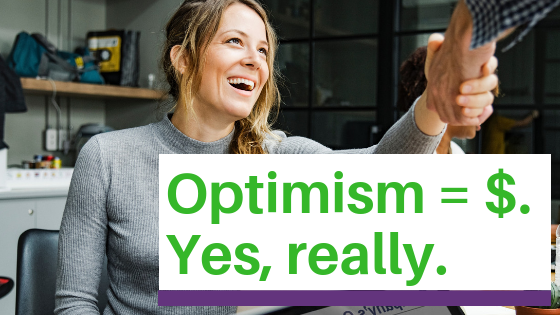Building optimism in your workplace isn’t just good for you and your team. It’s good for your profits.
Ask any business leader if he or she would like to build an optimistic culture, and of course they will say yes. It’s a no-brainer. You don’t need facts and figures to know that it’s simply more pleasant working in an environment in which people believe good things are possible every day.
But how do we get there? And is it possible to be too optimistic?
First, a definition. Let’s look at Workplace Optimism
According to this report over at Inc.com, workplace optimism ‘…is the way the environment feels to the people spending 30 to 50 percent of lives at work.’
Not an incredibly profound definition, sure. But more important than how it’s defined is what workplace optimism can do for those of us—as in, most of the human race—who spend at least a third of our adult lives in the workplace.
As the same report states:
‘This positive feeling gives others hope that good things will come from their hard work. In a positive workplace, people focus on what’s right and what’s possible–rather than being dragged down by idolising problems and polarising politics.’
And there you have it. Optimism = the recognition of the possible.
So building optimism is also creating an environment in which more possibilities exist. In this environment, barriers to success, or even simply making an attempt to get there, are brought down.
Michelle McQuaid, a leader in the field of positive psychology interventions in the workplace, conducted a studyback in 2012. Her findings were stark, and although they apply to America, they could fit almost anywhere in the world. Here are a few highlights:
- Just 36% of respondents were happy at their job.
- 31% of respondents felt uninspired or unappreciated.
- 15% of respondents reported feeling miserable, bored, and lonely.
Obviously, these numbers are not encouraging. They point to the urgent need for higher levels of optimism among workers.
So, how can we make that happen?
Ways to Build Optimism
Shawn Murphy, CEO of WorqIQ has a few helpful tips for purposefully creating optimism at work.
Among them are:
Create Clarity. Show employees exactly how their work has an impact on their co-workers, their customers, and the bottom line of the company itself.
Promote Positive Identity. Create an environment wherein positive, constructive feedback is a regular part of the process, and allow employees to engage in projects that give them a sense of excitement.
Magnify Meaning. Today, workers, particularly millennials, aren’t necessarily chasing the highest pay cheque. In fact, 71 per cent, according to one study, value “meaningful work” above all else.
Positivity and meaning, therefore, are inextricably linked in the modern work environment.
Avoid Blind Optimism
As is the case in all things in life, there must be a balance. When building up optimism in your place of business, don’t forget that negative emotions also have their time and place.
This excerpt from The Business Case for Happiness (PDF), published by the Stanford Graduate School of Business, sums it up nicely:
… research shows that negative emotions can lead to positive outcomes too. Negative emotions can lead to performance gain in the idea generation of group members by altering the coordination and motivation of group members. Negative emotions also draw attention to problems, spurring efforts to fix them.
In other words, building optimism isn’t necessarily about fighting pessimism. Some people are naturally optimistic, and others tend towards pessimistic. Whatever is someone’s natural tendency becomes part of their strengths.
The academic journal Social Cognition published a study in which researchers gave both optimists and pessimists puzzles that they were to solve. Half of the optimists were instructed to focus on negative thoughts, while half of the pessimists were told to consider only the possibilities that were before them, rather than what could go wrong.
The findings? The researchers determined that optimists perform best when they are allowed to be optimistic. And the pessimists? They, too, do their best work when allowed to perform within their natural frame of mind.
So, don’t try to make optimists out of pessimists. Encourage positive thinking, but not at the expense of robbing employees of a mode of thinking that works. It’s better to work to people’s strengths, while giving them the tools to be resilient.
Pitfalls of the ‘Ever Optimistic’ Leader
Entrepreneurial leadership expert Randy H. Nelson has written at length on different types of leaders, and their varying strengths and weaknesses. One of those leadership archetypes he has highlighted in his work is the “Ever Optimistic” boss. This type, he says, tends perpetually to focus on the bright side. Everything is great! If it ain’t broke, don’t fix it! Etc, etc.
For someone used to working for an overly pessimistic boss, this might seem like a dream come true. But it has a downside. When the good times end, the Ever Optimistic Person is at a loss for how to deal with things. If your optimist had been given the right tools to understand how to use her mindset to approach the situation, she would be much better off.
Ok ok, but what about my profits?
Looking at optimism from an abstract point of view is all well and good, but can an increased sense of optimism actually have a positive impact on a business’s profits?
It’s a question that researchers at the William Davidson Institute decided to analyse empirically. They compared the turnover growth expectations of 133 owners and managers with the actual outcomes. The study ran for a year. According to a detailed mathematical analysis, their findings were that entrepreneurial optimists do indeed see higher profits than their pessimistic counterparts.
In Summary
Your takeaway from all of this is that not only does optimism seem like a good idea, but there are hard figures — financial figures — to back it up. If you can breed optimism from the top down then, statistically, your business can and will perform better. However, you also need a broader resilience, so that your natural pessimists can work to their strengths, and your optimists aren’t lost when things go wrong.
It all starts with The ORANGES Toolkit
The O in ORANGES stands for Optimism. It’s the first of seven workshops delivered over a two-day program. The program empowers your team members to learn and use 40 mindset-improvement strategies. The program is so impactful that participants can put the strategies in place immediately.




Leave A Comment